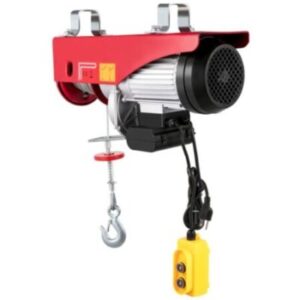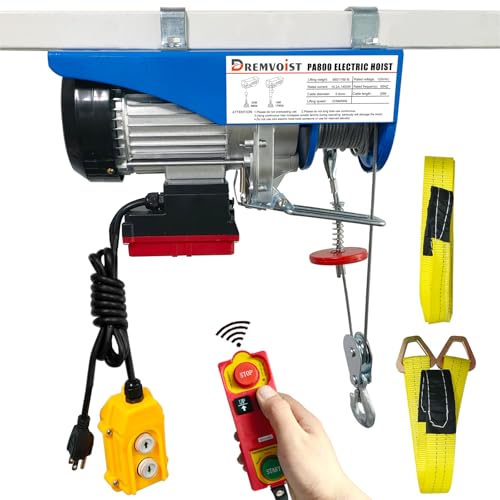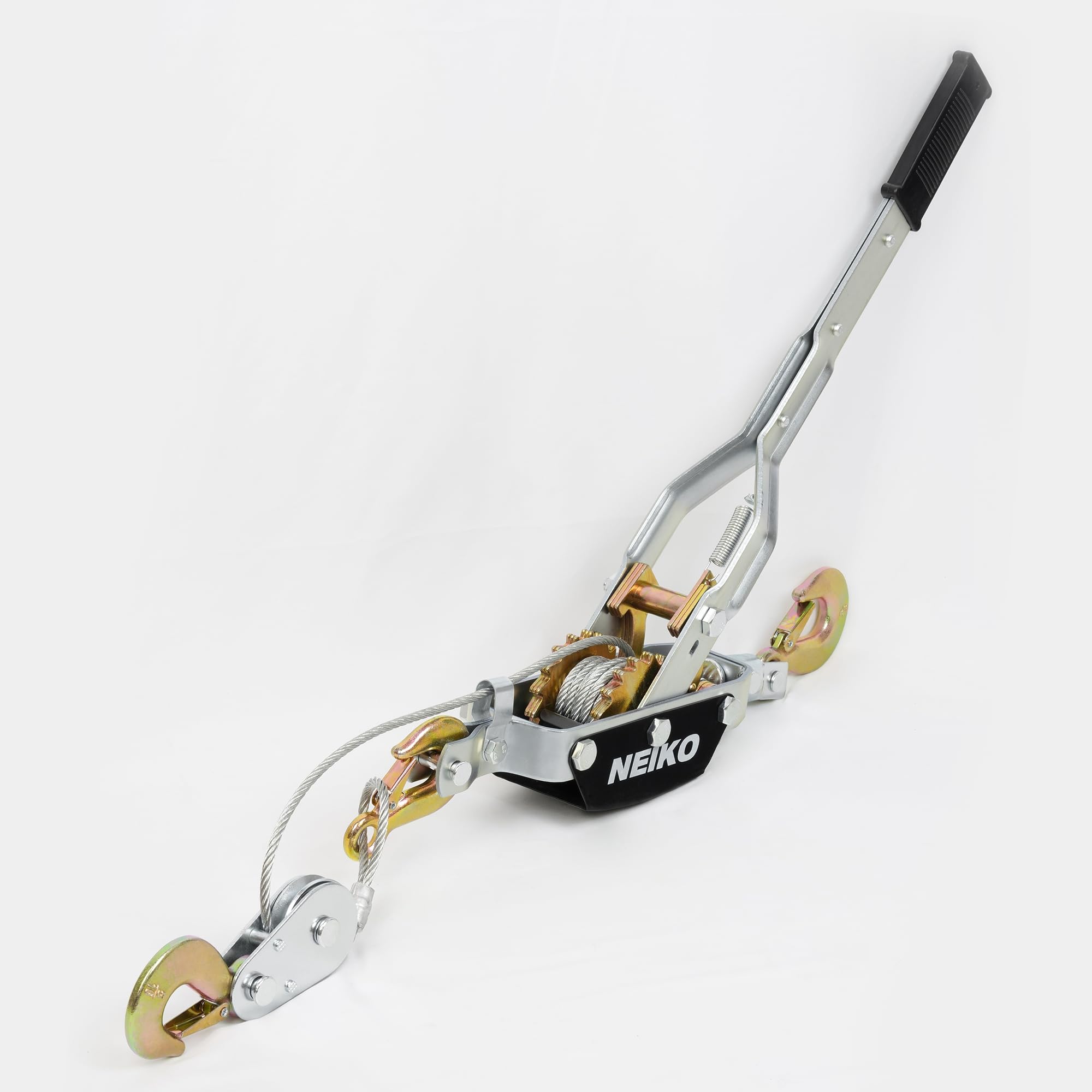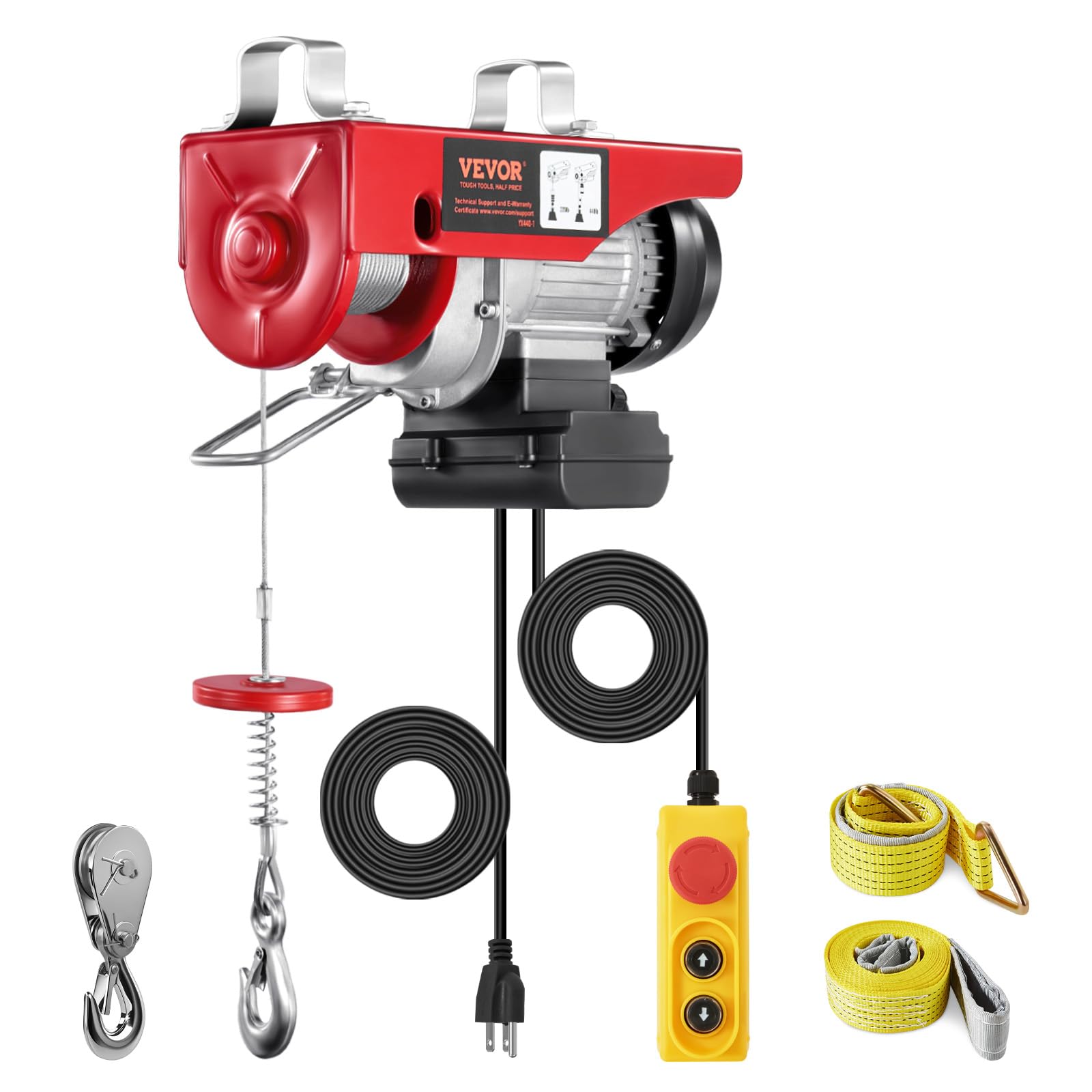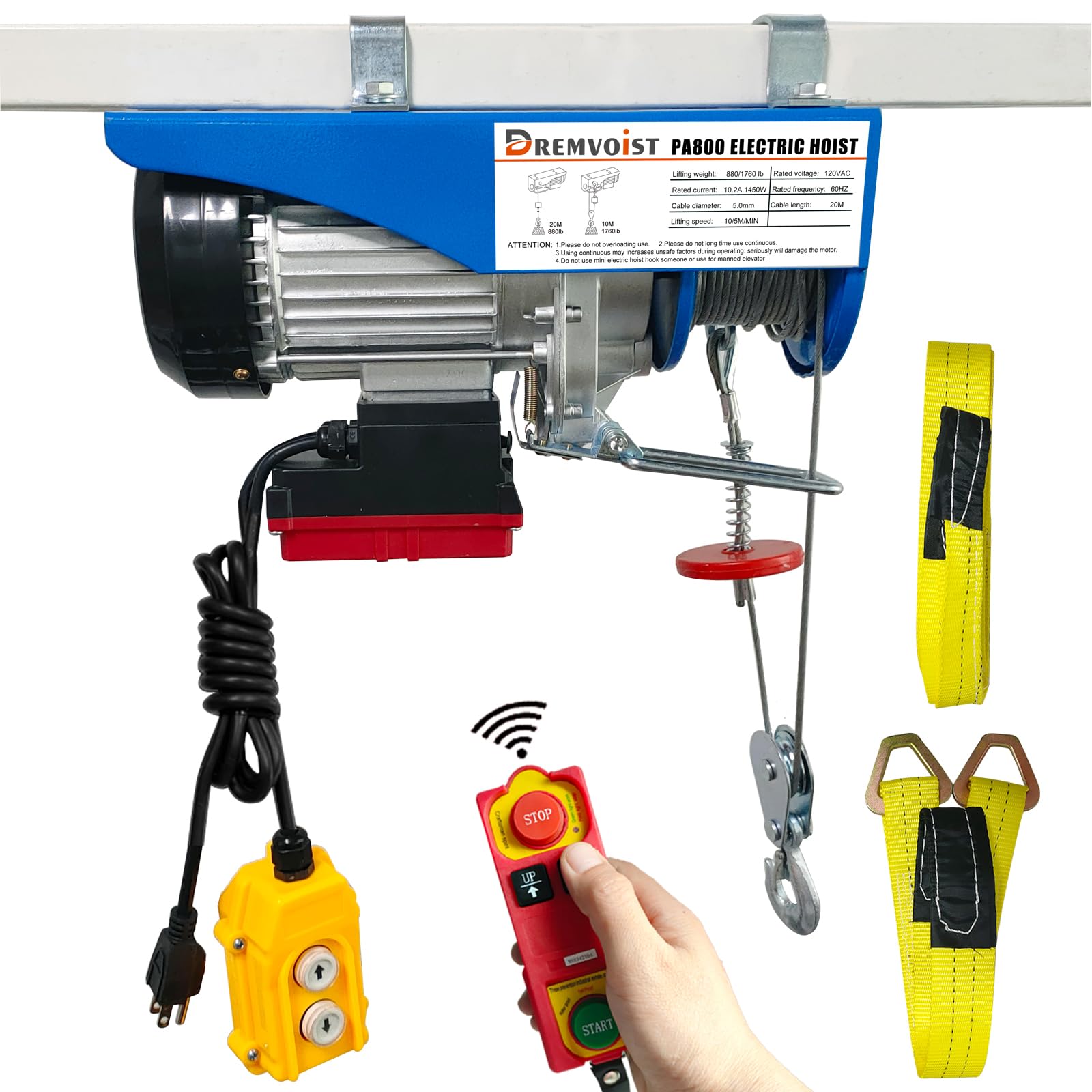| Product Image | Product Name / Our Rating / Price | Primary Button |
|---|---|---|
|
||
|
||
|
||
|
You rely on good lifting and pulling gear to make vehicle work, trailer loading, shop projects and emergency recoveries safer, faster and more repeatable. This guide helps you compare five practical winch hoists so you can choose the right tool for your garage, truck or trailer.
Understanding capacity, control type, mounting and duty cycle will save you time and keep you safer when you lift or pull heavy loads.
How We Picked These Winch Hoists
We focused on the features that matter when you actually use a winch: rated capacity and safety margins; rope or cable type (synthetic rope vs steel wire); motor power and duty cycle for repeated use; control options (wired, wireless, vehicle-mounted); physical size and mounting options for garages or trucks; durability and ingress protection (IP) for outdoor use; user feedback and reliability from verified reviews; and value for money including warranty and included accessories. You should prioritize capacity and duty cycle first, then controls and mounting compatibility for your intended use.
VEVOR 13,500 lb Electric Winch
- Delivers 13,500 lbs pulling force for vehicle recovery
- 6.6HP motor with 265:1 3-stage planetary gear for steady pulling force
- 3/8 in x 80 ft synthetic rope resists sunlight, wear, and breakage
- Alloy body provides durability against dust, rain, and harsh terrain
- 65.6 ft wireless remote and 9.8 ft wired remote for secure operation
- Universal mounting pattern fits most SUVs, pickups, and Jeeps
- Includes fairlead, hook, and power cables for fast setup and use
- IP55 waterproof rating for protection against elements
If you need a winch that can live in your garage and ride on your truck, this VEVOR 13,500 lb unit is the sort of tool you’ll reach for when something heavy needs to move. It gives you serious pulling power without a ton of fuss: a 12V motor, 80 ft synthetic rope, and both wired and wireless remotes so you can stand where you want while you work.
The IP55 rating and matte finish mean it’s built to stand up to rain, mud and trail grime, and the aluminum fairlead helps the rope run smoother. In everyday garage life it’s handy for loading cars onto trailers, hauling a stuck ATV out of the yard, or shifting heavy parts around. For special jobs—recovering a vehicle, pulling a boat onto a trailer, or winching a big load onto a flatbed—you’ve got the reach and control you need.
It’s not the fanciest control box out there, and a few owners recommend extra sheltering and routine maintenance, but for raw capability and flexibility it’s a practical, no-nonsense choice you can trust as long as you use it within its duty cycle and keep it cared for.
Safety Features
The synthetic rope reduces snapback risk compared with steel cable, and the winch includes an automatic braking system and both wired and wireless remotes so you can control pulls from a safe spot. IP55 protection helps keep water and dust out of critical parts. Still, always stay clear of the rope line, use gloves, follow rated capacities and duty-cycle guidance, and anchor the winch and load securely before operating.
Durability
Many owners report solid long-term use; the aluminum fairlead and matte finish help resist wear and corrosion. There are a handful of reports about control-box or motor corrosion in harsh conditions, so plan to protect the unit from constant salt exposure, rinse and dry after salty runs, and consider a cover and occasional electrical box inspection.
What It Solves
This winch solves a lot of sticky situations: getting a stuck vehicle out of mud, loading cars or tractors onto trailers, pulling a boat up onto a trailer, or moving heavy equipment around the shop. The remote options let you work from a safe position, and the long rope gives you reach for tricky anchor points.
Indoor/Outdoor Use
Designed primarily for outdoor use—IP55 weather resistance and rugged components—it’s also convenient in the garage for loading/unloading and workshop tasks if you have a 12V power source. Expect normal winch noise and keep the unit ventilated; avoid long continuous pulls beyond the recommended duty cycle indoors without proper power and ventilation.
Key Benefits
- High 13,500 lb line-pull capacity for heavy towing and recovery
- Both wireless and wired remotes give you flexible, safe control
- 12-strand synthetic rope is lighter and safer than steel cable
- IP55 protection and matte finish for weather resistance
- Aluminum fairlead reduces rope wear and improves routing
- Color-coded cables and straightforward instructions speed installation
Rating: 4.3 out of 5 (total: 261+)
NEIKO 4-Ton Come Along Winch
- 4-ton pulling capacity for heavy-duty use
- 9.8-foot long cable for extended reach
- Dual gears for evenly distributed force and smooth operation
- Three hooks with safety latches for added security
- Long hand-operated ratchet lever for leverage
- Durable steel construction and zinc-plated hooks and gears
- One-handed operation with ratcheting come along pulling system
- Portable and lightweight for easy transport
If you want a no-nonsense hand winch to keep in the garage or throw in the truck, this NEIKO 4-ton come-along is the kind of tool you’ll reach for when something needs a firm, controlled tug. It’s a manual ratchet-style puller with a long lever and dual-gear setup, a 9.8 ft cable, and three latching hooks so you can rig anchors and double up the pull when needed.
Around the yard it’s great for dragging stumps, tightening fence wire, or moving a stuck mower; on the road it’s handy for basic recovery or hauling a small load into position. It’s simple to use once you get the hang of the cable release and, with a little inspection before each use, it’s a practical, portable tool to have on hand.
Safety Features
Hooks include safety latches to help prevent accidental unhooking, and the ratchet mechanism holds load tension while you work. That said, some users have recommended inspecting retaining clips and pin hardware before each use and swapping weaker clips or using lock nuts if you plan heavy, repeated pulls. Always wear gloves, stand clear of the cable line, secure reliable anchor points, and never exceed rated capacity.
Durability
The body, hooks and gears are steel with zinc plating, so the unit stands up to regular yard and workshop use. Owners report long service when it’s not overloaded; the cable is the part most likely to need attention if you push limits.
Store it dry, lubricate moving parts occasionally, and inspect the cable, pins and clips before big jobs to keep it working longer.
What It Solves
This come-along makes short work of common headaches: freeing a stuck mower or ATV, straightening a leaning fence post, shifting a shed a few feet, or helping with light vehicle recovery when you don’t have a powered winch. It’s not for continuous industrial work, but for occasional heavy pulls around the property it gets the job done and gives you more control than straps alone.
Indoor/Outdoor Use
It’s built for outdoor use—yard work, ranch chores and roadside recovery—but it’s also handy in a garage since it doesn’t need power. Keep it sheltered from long-term moisture and salt, and avoid sustained heavy pulls in confined indoor spaces without proper anchoring and ventilation.
If you plan to use it on a truck, secure a solid anchor point and practice the release technique in a safe spot first.
Key Benefits
- 4-ton (8,000 lb) rated pulling capacity for heavy household and yard tasks
- Dual-gear ratchet gives smoother, more controlled pulls
- Three latching hooks increase rigging options and security
- Long ratchet handle with PVC grip makes cranking easier by hand
- Zinc-plated hooks and gears for better corrosion resistance
- Compact and portable — easy to keep in the truck or garage
Rating: 4.5 out of 5 (total: 7,568+)
VEVOR Electric Hoist (440 lb)
- 440 lbs lifting capacity with double-cable mode
- 14ft wired remote control for safe and easy operation
- Two modes of operation: single-cable for faster lifts and double-cable for heavier loads
- 480W pure copper motor for strong power and efficient operation
- Durable alloy steel construction and coated steel cable for stability and longevity
- Anti-tipping design and overheating protection for safe operation
- Easy installation with mounting brackets and lifting sling strap
- Versatile use in various settings such as garages, factories, and warehouses
If you need a simple way to lift heavy stuff around the garage or up into an attic, this VEVOR electric hoist is the kind of tool that quickly becomes useful. You get a wired 14 ft remote so you can stand clear while you raise or lower loads, and the unit supports single- or double-line setups so you can choose speed or extra capacity.
In everyday use you’ll appreciate how it handles tasks like lifting a generator, hoisting a mower deck for maintenance, or getting bulky gear onto a loft shelf. For occasional heavier jobs — moving a carcass for processing or positioning a car dolly — it saves you the awkward lifting and keeps things controlled.
It’s easy to hang from a beam or mount bracket, the steel body feels solid, and the auto-brake/limit switch features give you some peace of mind while you work. If you want a practical, at-hand lifting option for the shop or truck, this is a straightforward choice to consider.
Safety
The hoist includes an emergency stop button, top and bottom limit switches, an auto-brake and anti-spin rope to reduce the chance of sudden drops. Still, always respect rated capacities, use secure anchor points, and keep people clear of suspended loads.
Durability
The steel housing, thick braided cable and metal hook give a robust feel for garage and light commercial use. There are occasional reports of defects, so it’s wise to inspect the motor, wiring and spool before first use and after heavy jobs. Store it dry and don’t exceed the rated load to prolong life.
What It Solves
This hoist makes single-person jobs easier: lifting a generator, changing mower blades, raising attic storage, or helping load heavy equipment into a vehicle. It won’t replace an industrial continuous-duty system, but for occasional heavy lifts it removes the strain and gives you more control than manual methods.
Indoor/Outdoor Use
Designed mainly for sheltered use in a garage, workshop or under a covered beam, though you can use it on a truck if you secure a solid anchor. The wired remote is handy in tight spots; avoid exposing the unit to rain or corrosive environments and bring it inside when not in use.
Key Benefits
- 14 ft wired remote keeps you safely away from the load
- Two lifting modes: single-line for reach, double-line for more capacity
- 480 W copper motor with cooling fan for reliable pulls
- Solid steel body with 19-strand wire rope and metal hook
- Built-in safety: emergency stop, limit switch, auto brake, anti-spin rope
- Quick to mount — hangs on a beam or ceiling bracket with included straps
Rating: 4.4 out of 5 (total: 507+)
Dremvoist Electric Hoist (1760 lb)
- 1760LBS load capacity with 1450W high-quality motor
- Two operating modes: wireless remote control and wired remote control
- Triple safety protection: emergency stop switch, electromagnetic braking system, and limit switch
- Durable construction with steel, aluminum alloy, and galvanized steel wire cable
- Suitable for various applications: garages, shops, hotels, households, and outdoor environments
- Lifting height: 33FT (single line) and 65.6FT (double line)
- Speed: 33FT per minute (single line) and 16.5FT per minute (double line)
This Dremvoist PA800 is the sort of hoist you reach for when a one-person lift would otherwise be a chore. You can run it single-line for speed or double-line for the full 1,760 lb capacity, and the choice between a wired controller or a 328 ft wireless remote makes positioning the load simple. It’s great for pulling an engine, getting bulky storage into an attic, loading heavy gear onto a trailer, or hanging game — and reviewers mention it runs fine from an extension cord or generator when you need portability.
The build feels solid (steel/aluminum body, galvanized 19-strand rope) and it packs a few safety layers — emergency stop, electromagnetic brake and limit switch — so you can work with more confidence. If you want a flexible, garage-friendly hoist that handles tough weekend jobs and occasional heavier lifts, this one is worth a look.
Safety
Multiple protections are built in: an emergency stop, an electromagnetic braking system to hold loads, and a top limit switch to prevent over-travel. The unit also has a recommended duty cycle—avoid long continuous runs—and you should always anchor it to a rated support and keep people clear of suspended loads.
Durability
The hoist uses a steel and aluminum body with corrosion-resistant finishes and a thick galvanized wire rope, so it stands up to regular garage use. Some users note the unit is heavy and to check the motor and wiring on first use; store it dry and don’t exceed rated capacities to get the best life from it.
What It Solves
This hoist removes the awkward lifting from jobs like engine removal/installation, moving heavy yard equipment, loading toolboxes onto trailers, or raising attic storage. It won’t replace a continuous-duty industrial hoist, but for weekend mechanics, mobile work with a generator, or one-person rigging it makes tricky lifts manageable and safer.
Indoor/Outdoor Use
Best used in a sheltered spot — garage, workshop, under a canopy or a secure truck mount. The wireless remote is handy when you’re on a trailer or truck bed, and users have run it from a generator or with a long extension cord.
Avoid exposing the hoist to rain or corrosive conditions and bring it indoors when idle.
Key Benefits
- Dual wired and 328 ft wireless remote for flexible control
- Switchable single-line (880 lb) or double-line (1,760 lb) setups
- High-power motor for steady lifting and usable with extension cords or generators
- Triple safety protection: emergency stop, electromagnetic brake, limit switch
- 19-strand galvanized steel rope and steel/aluminum housing for rugged use
- Includes lifting straps and works well for engine work, attic storage, and trailer loading
Rating: 5 out of 5 (total: 6+)
How Do You Choose The Right Winch Hoist For Your Garage Or Truck?
You should match the winch to the task, not the other way around: pick a capacity at least 1.5–2× the maximum load you expect to move to account for angles, friction and safety. Consider the power source: 12V DC truck winches like heavy-duty truck models are designed to run from a vehicle battery and are better for towing and trailer work, while 110V AC electric hoists are often more convenient in a fixed garage setup.
Pay attention to Duty Cycle and cooling requirements if you plan repeated or long pulls; a high-capacity truck winch with a low duty cycle can overheat if you use it continuously. Decide on rope type: synthetic rope is lighter and safer when it breaks, steel cable resists abrasion better but requires gloves and careful handling.
Check mounting and anchor requirements — your bumper, winch plate or overhead beam must be rated for the dynamic forces. Look for practical features such as wired and wireless control options, IP or weather ratings for outdoor use, and what accessories are included (fairleads, hooks, remote controllers). Finally, read user feedback on real-world reliability and common failure points so you can plan for upgrades or spare parts.
What Safety Checks And Best Practices Should You Follow When Using A Winch Hoist?
You must inspect equipment before every use: check the rope or cable for frays, broken strands, kinks or chemical damage and verify hook pins, bolts and retainers are secure; if you use a come‑along, pay special attention to retaining clips and pins. Always anchor to a rated point and, when possible, use a snatch block to reduce load on the winch and to double line capacity.
Keep bystanders clear and never stand over or beside a loaded line; use a dampener on the rope where practical to reduce recoil energy. For electrical winches and hoists, ensure the power supply and cable gauge match manufacturer recommendations and protect 110V hoists with a GFCI; for 12V truck winches ensure your battery and alternator can handle the draw and use heavy‑gauge, short leads. Respect duty cycle limits, allow the motor to cool between heavy pulls, and protect synthetic rope from chafing and UV exposure with a cover.
Keep control units and solenoid boxes dry and inspect connectors — many issues reported stem from wiring, control modules or corrosion, so test controls and emergency stops before each operation.
When Should You Choose A Manual Come‑Along Versus An Electric Winch Or Garage Hoist?
You should consider a manual come‑along when portability, simplicity and low frequency use are priorities: come‑alongs are compact, require no power source and are excellent for pulling vehicles out of mud, adjusting fence lines or short, controlled pulls. For heavier, repeated or precision lifts — such as changing engines, lifting deer for processing, or hoisting items from an attic — an electric hoist or powered winch is safer and far less labor intensive.
Remember manual pullers have different failure modes and require careful inspection of mechanical pins, gears and cables; a user review history that mentions missing hooks or weak spring clips is a signal to inspect and, if needed, upgrade those parts. If you plan to switch a winch between truck and garage, check mounting compatibility and verify the winch’s power needs and environmental rating; converting a truck 12V winch for fixed overhead garage use is possible but demands correct mounting hardware, rated beams and safe electrical arrangements.
Wrapping Up
When you pick a winch hoist you want equipment that matches the loads you plan to move, the place you will mount it and how often you will use it. If you need high towing or recovery capacity for trucks and trailers, prioritize rated capacity and a durable mounting solution.
If you want a simple workshop solution for engines and gear, choose a mid‑capacity electric hoist with wired and wireless controls. For a low-cost, no‑power backup, a manual come-along covers many needs.
Use the selection criteria here to match a model to your use case and always inspect mounts, wiring and safety hardware before each lift.
This Roundup is reader-supported. When you click through links we may earn a referral commission on qualifying purchases.


